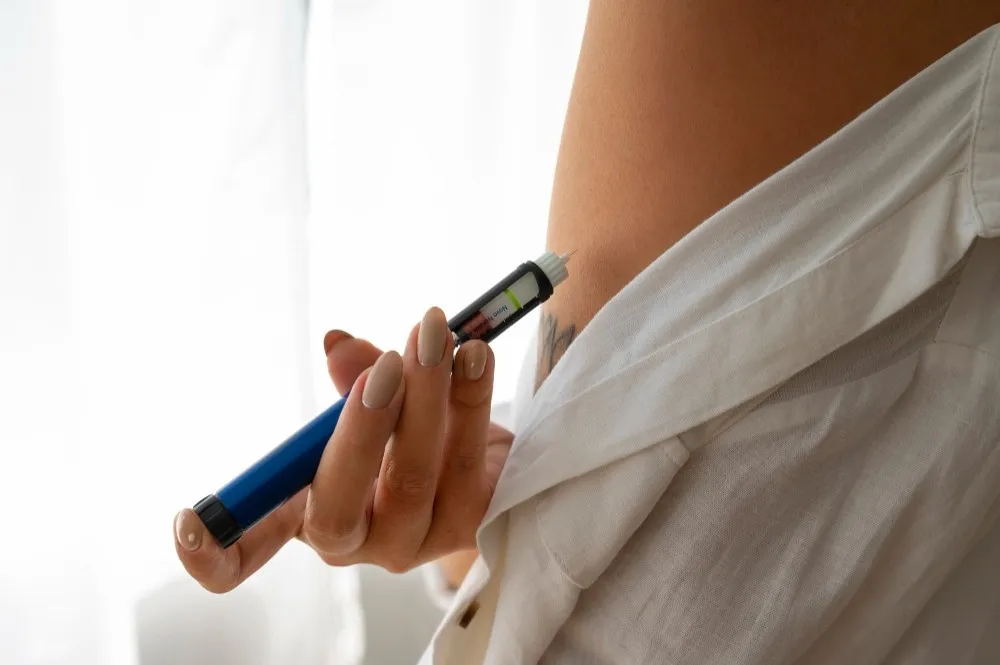Men can look and feel different signs of diabetes in them, but do you know that identifying and treating these unusual symptoms can be difficult for women? For many reasons, women are more averse to pain, and sometimes they can neglect the signs of something that occurs to them constantly. Diabetes is a group of metabolic diseases that can make a person have higher blood glucose levels, and they can be known as blood sugar problems that can spike the hormones and insulin levels. The body may need insulin to make and use energy from the carbohydrate that can lead to a better quality of life. Continue reading this blog to learn more about the causes and Signs of diabetes in women. This blog also suggests some prevention methods to reduce the risk of diabetics. 
What are the two common types of diabetes?

- Type one diabetes is when the body can't make insulin due to autoimmune dysfunction, and type two diabetes is the most common and occurs when the body cannot properly use insulin gestation.
- Diabetic can affect people with any lifestyle and of any age, race and ethnicity or group, or gender. These conditions can have more severe symptoms in women than in men.
- Women and men with diabetes can experience many of the same symptoms; however, some symptoms are unique to women, while others can help in identifying diabetes and getting proper treatment for the same.
What are the potential causes of diabetes in women?
Diabetes in women can have various causes and risk factors. Here are some common factors that contribute to the development of diabetes in women:- Genetics and Family History- Women with a family history of diabetes have a higher risk of developing the condition. If a woman has immediate family members (parents or siblings) with diabetes, her risk may be higher.
- Obesity and Excess Weight- Obesity and excess weight are significant risk factors for developing type 2 diabetes in women. When a woman is overweight or obese, the body's ability to use insulin effectively becomes compromised, leading to insulin resistance. Insulin resistance means that the body's cells are less responsive to insulin, resulting in elevated blood sugar levels.
- Sedentary Lifestyle- When a woman engages in minimal physical activity and spends long periods sitting or being inactive, it can have detrimental effects on their overall health, including diabetes risk. Lack of physical activity or leading a sedentary lifestyle can also cause weight gain, lead to insulin resistance, and impaired glucose metabolism, increasing the risk of developing diabetes in women. Regular exercise helps improve insulin sensitivity and blood sugar control.
- Polycystic Ovary Syndrome (PCOS)- PCOS is often associated with weight gain and obesity. Excess weight further exacerbates insulin resistance and increases the likelihood of developing type 2 diabetes. PCOS is a hormonal disorder that affects women of reproductive age.
- Gestational Diabetes- Gestational diabetes is a form of diabetes that occurs during pregnancy. It affects pregnant women who previously did not have diabetes but develop high blood sugar levels during pregnancy. Women who develop gestational diabetes during pregnancy are more likely to develop type 2 diabetes later in life.
- Age- As women grow older, their risk of developing diabetes tends to increase. This means that the chances of getting diabetes become higher as they get older. In particular, women who are 45 years old or above have a greater likelihood of developing diabetes compared to younger women. Women in this age group need to be aware of the potential risks and maintain a healthy lifestyle, such as eating a balanced diet and being physically active, to reduce their chances of developing diabetes. Regular check-ups with a doctor can also help detect and manage diabetes early on.
- Hormonal Changes- Hormonal changes during menopause can affect insulin sensitivity and contribute to the development of diabetes in some women. Also, these Hormonal Changes lead to weight gain and uncontrolled levels of sugar.
What are the Signs of Diabetes in women?
While both men and women can have the same symptoms of the condition, some of these symptoms are different for women, and these can be seen early on while checking for diabetes.-1. Candida Infections can be seen in women with diabetes-
- Candida infections can be caused by hyperglycemia.
- Low blood sugar levels can also trigger the growth of the fungus, and an overgrowth of the yeast can cause the candida fungus to grow faster.
- These infections can also result in vaginal or oral yeast infections.
- These common infections are also known as thrush.
- Some other symptoms of candida infections can include vaginal itching, vaginal discharge, and painful sex.
- Soreness in the tongue and oral yeast infections can also lead to a white coating on the tongue inside the mouth.
2. Urinary tract infections or UTIs are very common with female diabetes-
- Urinary tract infections can develop when bacteria enter the urinary tract, and the risk is higher in women with diabetes.
- UTIs are common causes in this group mainly because hyperglycemia compromises the immune system.
- It can be seen if you have painful urination, a burning sensation during excreting the urine, blood in urine, cloudiness, and the risk of kidney infections if the symptoms are not treated.
3. Vaginal dryness is commonly seen in women with diabetes-
- One of the most significant Signs of diabetes in women includes Vaginal dryness.
- Vaginal dryness can be a response of the body trying to compensate for the need for excessive hunger and thirst.
- Vaginal dryness can also be due to UTI infections or candida and thrush. Some of these can also impact physical symptoms like itching and rashes. Thus, it should be addressed.
4. Diabetic neuropathy or the tingling sensation in the body parts-
- Diabetic neuropathy occurs when higher blood sugar levels damage short nerve fibers.
- This damage can trigger a tingling sensation or loss of feeling in the body parts like legs, arms, and the entire skin.
- This can also affect the sensitivity in the vaginal area and lead to symptoms like vaginal dryness and polycystic ovarian disorders.
5. PCOS or PCOD can also be a sign of diabetes in females -
- Experts do not know the exact cause of polycystic ovary syndrome, and it can occur when women produce too much of the androgen hormones and cause certain risk factors, like a family history of PCOS.
- As per researchers, the main androgens involved in PCOS are testosterone and androgens, which can cause various symptoms and complications in women. These elevated androgen levels can contribute to irregular menstrual cycles, blood sugar spikes, excessive hair growth (hirsutism), acne, and even male-pattern baldness in some cases.
- Other symptoms include irregular periods, weight gain, acne, depression, and infertility.
- Increased thirst
- Increase in hunger
- Frequent urination
- Weight loss or weight gain with try to lose or gain weight
- Fatigue and a constant feeling of hunger
- Vomiting or nausea
- Blurred vision
- Wounds heal slowly
- Skin infections and UTI infections
- Dark patches of skin at the armpits, groin, and back of the neck
- Breath that has a sweet, fruity, or acetone-like odor
- Reduced sensations in the hands or feet
Why does diabetes affect women differently than men?
- Women often are less receptive to aggressive symptoms of many health conditions like cardiovascular and diabetic-related conditions.
- Women tend to overlook the symptoms they have developed and leave them to get cured on their own.
- This feeling of trying to heal themselves and ignoring their pain is one reason women react differently to diabetes than men.
- Thus, if you develop the symptoms, you must contact your doctors and let them know about the problem.
Medications that can help women prevent diabetes?
- Various medications can be used to manage the symptoms and effects of the condition.
- Many new classes of diabetes medicine are available, and the most common drugs are for those who have recently received a diagnosis, including insulin therapy, metformin, and lifestyle changes that can damage with
- Exercising and maintaining a healthy weight can also help.
- Avoiding smoking and cigarettes and following a balanced eating plan that meets the needs of the person, including fruits, vegetables, and whole grains
- Monitoring the blood sugar levels is essential.
Conclusion-
In 2023, there will be an increase in type 2 diabetes, many of which are women. Signs of diabetes in women include increased thirst, frequent urination, unexplained weight loss, fatigue, blurred vision, slow wound healing, and recurrent infections such as yeast infections. Sustainable treatment goals can help conclude that meeting specific goals like lowering the density of lipoprotein can help increase life expectancy, and there are a variety of medications, lifestyle changes, and alternative medications that can help manage your symptoms and improve your overall health.Talk to your friends, family, and doctors if you want to explore new treatments like insulin therapy. Even if you think you do not have diabetes, getting tested once per year is safer.Frequently Asked Questions
What is the early sign of diabetes in women?
The early signs are thirst, hunger, and even eating a lot.
Ho, do you know if one has diabetes?
One can know if they have diabetes because their blood test shows an elevated blood sugar level.
What happens when a woman is a diabetic?
Diabetes increases the risk of heart disease about four to five times.
At what age can women have diabetes?
Women can get diabetes at any age.
Can one detect diabetes early in women?
It can be challenging to detect diabetes, but a blood test can help diagnose diabetes in women.

Reviewed by







